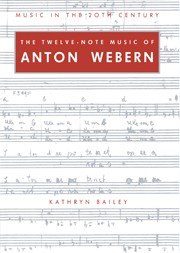Summary
When, in 1924, Webern took up the twelve–note method of writing music, he became part of a compositional movement which a few decades later was to drive music analysts to invent completely new methods of dissection. The New Music's projection of tonal relationships as specific to individual situations, and the increased importance – in many cases independence – afforded rhythm, timbre and register have led to a microscopic attention to detail in an attempt to explain and understand. The unique possibilities inherent in each row are exhaustively described; pitch–class content, rhythmic details, durations, register and timbral changes are minutely examined and catalogued. The result is a great deal of information about the sound complex of each work and, if the analysis is acute, an explanation of the way in which the music derives specifically from the row that generated it. The complexion of the music dictates the approach taken; each result is unique.
Analysis can be approached either with the intention of cataloguing and defining all the events and relationships that one can perceive (aurally and/or intellectually), or with the purpose of examining and elaborating upon the composer's concept of the piece. The kind of analysis just described is of the first sort. The information it yields is an essential component of our knowledge of any piece of music, since anything that exists in the music obviously does – or may – contribute to our perception of it. It does not tell the whole story, however. In many cases works are not presented as entities, but rather as constellations of minute details, lying outside the province of historical perspective. Moreover, it seldom represents the composer's conceptions.
- Type
- Chapter
- Information
- The Twelve-Note Music of Anton WebernOld Forms in a New Language, pp. 331 - 334Publisher: Cambridge University PressPrint publication year: 1991

